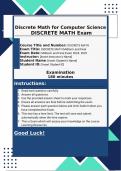Discrete Mathematics Final Exam Review
Questions and Answers | 100% Pass
Discrete Math for |Computer
Guaranteed Graded A+Science
|
DISCRETE MATH Exam
Course Title and Number: DISCRETE MATH
Exam Title: DISCRETE MATH Midterm and Final
Exam Date: Midterm and Final Exam 2024- 2025
Instructor: [Insert Instructor’s Name]
Student Name: [Insert Student’s Name]
Student ID: [Insert Student ID]
Examination
180 minutes
Instructions:
1. Read each question carefully.
2. Answer all questions.
3. Use the provided answer sheet to mark your responses.
4. Ensure all answers are final before submitting the exam.
5. Please answer each question below and click Submit when you
have completed the Exam.
6. This test has a time limit, The test will save and submit
automatically when the time expires
7. This is Exam which will assess your knowledge on the course
Learning Resources.
Good Luck!
,Read All Instructions Carefully and Answer All the
Questions Correctly Good Luck: -
For each of these lists of integers, provide a simple
formula or rule that generates the terms of an integer
sequence that begins with the given list.Assuming that
your formula or rule is correct, determine the next
three terms of the sequence.
a) 1, 0, 1, 1, 0, 0, 1, 1, 1, 0, 0, 0, 1,...
b) 1, 2, 2, 3, 4, 4, 5, 6, 6, 7, 8, 8,...
c) 1, 0, 2, 0, 4, 0, 8, 0, 16, 0,...
d) 3, 6, 12, 24, 48, 96, 192,...
e) 15, 8, 1, −6, −13, −20, −27,...
f) 3, 5, 8, 12, 17, 23, 30, 38, 47,...
g) 2, 16, 54, 128, 250, 432, 686,...
h) 2, 3, 7, 25, 121, 721, 5041, 40321,... - Answer>>
NA
Look at Unit 2.6 - Answer>> NA
4.1
Suppose that a and b are integers, a ≡ 4 (mod 13), and
b ≡ 9 (mod 13). Find the integer c with 0 ≤ c ≤ 12 such
that
a) c ≡ 9a (mod 13)
b) c ≡ 11b (mod 13)
c) c ≡ a + b (mod 13)
d) c ≡ 2a + 3b (mod 13)
e) c ≡ a2 + b2 (mod 13)
f) c ≡ a3 − b3 (mod 13). - Answer>> NA
4.1
Evaluate these quantities.
a) 13 mod 3
b) −97 mod 11
,c) 155 mod 19
d) −221 mod 23 - Answer>> NA
4.1
Find a div m and a mod m when
a) a = 228, m = 119.
b) a = 9009, m = 223.
c) a = −10101, m = 333.
d) a = −765432, m = 38271. - Answer>> NA
4.1
Find the integer a such that
a) a ≡ −15 (mod 27) and −26 ≤ a ≤ 0.
b) a ≡ 24 (mod 31) and −15 ≤ a ≤ 15.
c) a ≡ 99 (mod 41) and 100 ≤ a ≤ 140. - Answer>>
NA
4.1
Find each of these values.
a) (−133 mod 23 + 261 mod 23) mod 23
b) (457 mod 23 · 182 mod 23) mod 23 - Answer>> NA
4.2
Convert the decimal expansion of each of these
integers to a binary expansion.
a) 231
b) 4532
c) 97644 - Answer>> NA
4.2
Convert the binary expansion of each of these integers
to a decimal expansion.
a) (1 1111) sub 2
b) (10 0000 0001) sub 2
c) (1 0101 0101) sub 2
d) (110 1001 0001 0000) sub 2 - Answer>> NA
, 4.2
Convert the octal expansion of each of these integers
to a binary expansion.
a) (572) sub 8
b) (1604)sub 8
c) (423)sub 8
d) (2417)sub 8 - Answer>> NA
4.2
Convert the hexadecimal expansion of each of these
integers to a binary expansion.
a) (80E)sub 16
b) (135AB)sub 16
c) (ABBA)sub 16
d) (DEFACED)sub 16 - Answer>> NA
4.3
Determine whether each of these integers is prime.
a) 21
b) 29
c) 71
d) 97
e) 111
f) 143 - Answer>> NA
4.3
Show that log sub 2 3 is an irrational number. Recall
that an irrational number is a real number x that cannot
be written as the ratio of two integers. - Answer>> NA
4.3
What are the greatest common divisors of these pairs
of integers?
a) 3^7 · 5^3 · 7^3, 2^11 · 3^5 · 5^9
b) 11 · 13 · 17, 2^9 · 3^7 · 5^5 · 7^3
c) 23^31, 23^17
d) 41 · 43 · 53, 41 · 43 · 53




